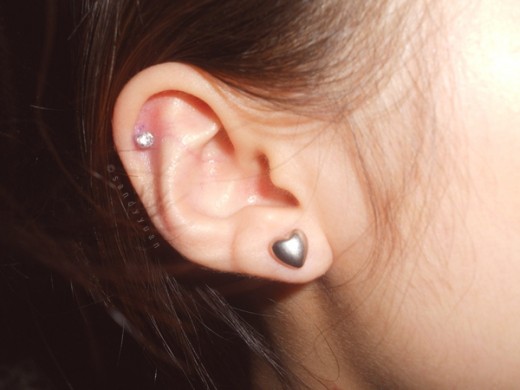Piercing your ear cartilage is a choice you want to last by doing everything you can to help it heal well. The piercing was done by a professional body piercer using the highest quality implantation steel captive bead ring or stud under sterile conditions. That is not enough to guarantee normal healing. You have to learn the right cartilage piercing care to make sure that your piercing heals well and without any problems. An infection can be serious, so knowing how to recognize symptoms of abnormal healing and infection is important so you can take steps to clear the infection fast. Once your healing is complete, your piercing will last long and become a great part of your life and appearance.
Dos and Don'ts for Cartilage Piercing Care

The basics of cartilage piercing care are easy. What creates the most problems for people are the expectations they have for how long the healing process will take. Depending on the type of piercing you have, it can take up to 8 months for the piercing to heal. That doesn't mean the process is done yet. It won't be until 1 year after the piercing date that the piercing is considered "seasoned." During the seasoning period, you have to be very cautious about changing the jewelry that you wear or choosing to wear anything that will strain the piercing. It can be very easy to open the piercing and get an infection if you do not properly care for it during the healing process and seasoning period.
What You Should Do
Cartilage piercing care is surprisingly easy if you do what you should.
- Wash the piercing with clean water or a saline solution only. Even just letting shower water run over the piercing is enough, but don't let soap from shampoo cover the piercing.Pat dry the area after it has been cleaned and only use hypoallergenic jewelry that fits snugly in place. Or, if the wound really hurts, you can use saline to soak it a bit to help with healing.
- When you do touch the piercing, always make sure that your hands are clean and dry first.
- A healthy lifestyle will also help. Try to eat more nutritious foods, get adequate sleep, and exercise regularly to have a healthy body and a strong immune system to ward off infection.
- You should also keep your bedding and pillow case clean so as to prevent infection.
What You Should Avoid
There are several things that should be avoided during the healing process.
- The two most important are to avoid touching the piercing unless absolutely necessary, and to avoid exposing it to harsh soaps, cleaners or chemicals. That means no swimming, no commercial piercing cleaners and don't twist or touch the piercing.
- You should also consider quitting smoking while it heals too as smoke can be a major irritant and don't let any one touch it, or have any body fluids come in contact with it. Don't use any type of jewelry for the first year other than standard, hygienic steel inserts. This will allow the piercing to heal completely.
- Don't twist the piercing to break the crust. The crust is an important part of the healing process so leave it alone.
How Long Does It Take to Heal?
The different parts of the body have different healing time and not everyone will heal over the same time span. Below you will find a list of the general healing times for the commonly pierced parts of the body. The healing times represent the time frame that you have to engage in cleaning of the piercing.
- 2 to 8 weeks - Hood, Inner Labia, Prince Albert
- 3 to 8 weeks - Tongue, Tongue web, Lip frenulum
- 2 to 4 months - Earlobe, Eyebrow, Labret, Lip, Monroe, Medusa, Vertical Lip
- 2 to 6 months - Nostril, Septum, Bridge
- 3 to 6 months - Frenum, Guiche, Scrotum
- 3 to 12 months - Ear Cartilage, Navel, Nipple, Transverse Lobe
- 4 t 12 months - All surface piercings such as nape, cleavage, pubic and so on, as well as Triangle, Ampallang, Apadravya
How Do I Know If My Cartilage Piercing Is Healed, Irritated, or Infected?
A swollen piecing with discharge can make you think that you have an irritated or infected piercing, but that is actually what a normal healing process may look like. When talking about correct cartilage piercing care the terms used are an "angry" piercing and an "infected" one. An angry piercing is
- irritated
- swollen
- and can give off a discharge
It is considered to be healing normally as it is natural that the tissue would be irritated and the pus discharge is also a part of the healing process. That cloudy discharge is what forms the crust that works to protect the piercing site as it heals. It can also bleed lightly.
A site is considered infected when it
- becomes red around the edges
- becomes painful to the touch
- gives off a foul odor
Those are the most common signs of an infected piercing, but you should also
- look for signs of streaks or marks in the surrounding tissue,
- feel the piercing to see if it is hot or warm to the touch
- as well as paying attention to unusual swelling beyond what may be normally expected.
You must see a physician to deal with an infected piercing site to get your healing back on track fast. Cartilage piercing care is easy, but to make sure it goes well you have to address any issues as fast as possible.
